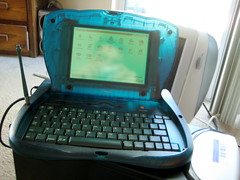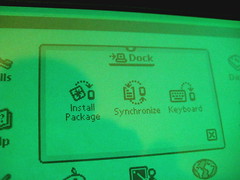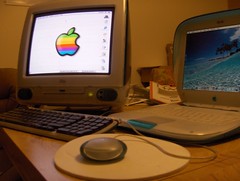
Look what I got.
After wondering whether to spring for an Apple Newton eMate 300 or wait for an MP2100, the cheap-o route seemed like the best one for right now (economic downturn and all). And I’m not sorry I did: this Newton gives me the chance to play around with OS 2.1 and the software that requires it, which makes all the difference in the world when you’re trying to manage an all-Newton blog.
The eMate was Apple’s Newton entry into the education market. Like a small word processor, it featured a shrunken keyboard (perfect for fifth grader fingers), a 25 MHz ARM 710a RISC processor, and shipped with the Newton OS 2.1. It’s slower than the MP2000 and MP2100, but it wasn’t designed to be a road warrior machine. In fact, browsing through the software, it struck me how classroom-geared this thing really was. The eMate 300 was killed with the rest of the Newton family during the Stevepocalypse of 1998, meaning it only lasted a year.
As usual, eBay sent me an offer I couldn’t refuse: $20 for the eMate, plus shipping, at it was at my doorstep a mere days later. The eMate fired right up, and after clearing off some of the previous owner’s personal information (tip: do this before you sell anything on eBay), I poked around and even wrote a little journal entry, just to try out the keyboard.
My first worry was whether it would sync with my iMac G3 (running OS 9.2.2) via Newton Connection Utilities:

As you can see, I didn’t have much to worry about. My generic Entrega U1-D8 serial-to-USB adapter worked just fine – as it does with my MP100. Next I wanted to try installing a piece of software, Pocket Quicken, that’s been sitting on my desktop for months now:

This worked fine, too, although I haven’t had time to play around with it yet. The point is, the serial-to-USB connection does what it’s supposed to.
Finally, I wanted to try and export the little journal entry I wrote in Newton Works – maybe into a TXT file or AppleWorks document I could read:

Bonk! My first hurdle. Apparently you need good ol’ ProDOS to read the exported file. ProDOS! I’ll figure out the export deal, too, eventually.
Later, I attempted a eMate-to-OS X connection with NewtSync, but the Entrega adapter wouldn’t parse the connection. The adapter needs a driver that only works with OS 9. Now I’ll work on getting a Keyspan adapter and finally connect my Newton with a modern Mac.
Fun times ahead, folks, now that I have a more modern Newton. My only wish is that it came with a refurbished battery. This eMate’s battery dies when you unplug it, which means no trips to the park to type out blog entries. Other than that, it works great, is fun to mess around with, and I can’t wait to install and try out the gobs of software titles that are out there. Stay tuned.










